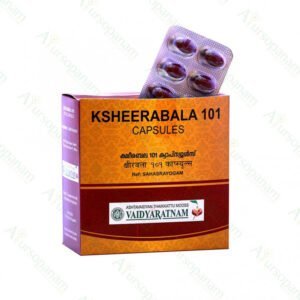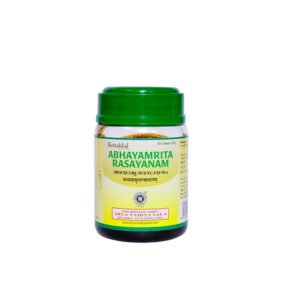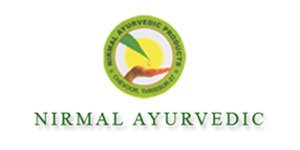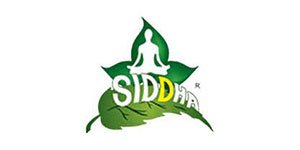Nadi Kashayam is a traditional preparation in Keraleeya Ayurveda that promotes healing in the human body. It is used in the management of blunt trauma and bruising, sprains and fractures, weakness of respiratory muscles, nerve debility and also in the post-partum period.
Kashaya or herbal decoctions harness the healing properties of herbs and roots in a mild and easily absorbable water base. Nadi Kashayam counters inflammation and relieves the pain, swelling and loss of function associated with it.
Features & Benefits
- It heals the body from within. Nadi Kashayam is an important part of the post-natal Ayurvedic regimen in Kerala.
- It draws out deep tissue inflammation. Relieves inflammatory pain and swelling. Beneficial in the management of traumatic injuries.
- Vata aggravation manifests as pain, rigidity, and loss of mobility in the body. Nadi kashaya pacifies the erratic Vata and restores function.
Dosage and Instructions
Adult: 15-20 ml of Nadi Kashayam mixed with 45-60 ml of boiled and cooled water, twice daily on empty stomach.
Child: 10-15 ml of Nadi Kashayam mixed with 30-45 ml of boiled and cooled water, twice daily on empty stomach.
Key Ingredients
Vilva (Aegle marmelos)
The Bael tree or Bilva (in Sanskrit) is an ancient Ayurvedic tree known for its spiritual and medicinal importance. It is one of the Dashamoola (group of ten roots) herb. Belpatra is said to have anti-inflammatory properties and can be applied on any inflamed region for quick relief. Bael is said to have anti-fungal and anti-viral properties, due to which it is used in treating a number of infections in our body.
Bala (Sida cordifolia Linn)
The Ayurvedic system of medicine considers Balaor Sida cordifolia as a tonic, astringent, emollient, and aphrodisiac. The drug also forms a chief ingredient of several important formulations and preparations in Ayurveda. Internally, Balais believed to be a very effective nervine tonic and Rasayana for all kinds of Vata disorders.
Bhadrika or Gorakhagunja (Aerva lanata)
Bhadrika is used in Ayurveda for renal calculi, urinary retention, cough, and sore throat. The plant has anti-HIV, and antibacterial property too.
Vasaka (Adathoda vasika)
Vasaka herb is used for treating cold, cough, chronic bronchitis, and asthma. in acute stages of bronchitis, Vasaka gives unfailing relief, especially where the sputum is thick and sticky. It liquefies the sputum so that it is brought up more easily. For relief in asthma, the dried leaves should be smoked. The juice from its leaves should be given in doses of 2 to 4 grams in treating diarrhea and dysentery.
Brihati (Solanum indicum)
The use of Brihatiin this oil helps reduce Vata disorders. It treats different types of skin infections and nourishes and rejuvenates the skin.
Pushkaramoola (Coffea travancorensis)
Pushkaramula has been used to treat cardiovascular and respiratory problems as well as for weight loss. Other conditions treated traditionally with Pushkaramula include bacterial infections, blood sugar metabolism problems, asthma, bronchitis, cough, and heart disease. Literature suggests it works by protecting antioxidants in the body and increasing their function.
Ela (Elettaria cardomum)
Elaichi has very good antibacterial and antifungal properties. It helps in reducing inflammation. Cardamon is often given the epithet Queen of Spices as it is used to flavor food in many countries. in addition, the herb has several health benefits. The German Commission E has indicated the use of Cardamom in dyspepsia and as a cholagogue, which promotes bile discharge from the system. The herb is also helpful in treating gum and teeth infections, throat congestion and kidney disorders.
Maricha (Piper nigrum)
Pepper is native to the Western Ghats of India. It is cultivated for its fruit, which is widely used as a spice and in traditional Indian medicine preparation. Black pepper is an appetizer and carminative commonly used in the treatment of digestive system-related complaints like dyspepsia, indigestion, flatulence, nausea, diarrhea and colic pain. in the respiratory system, it acts like an Expectorant used in Cough, cold and chest congestion. Externally used as an analgesic and in Vitiligo it stimulates the production of pigments.
Pippali (Piper longum)
Pippali is known as “Tridoshic” herb as it suits all body types. Regular consumption of Pippali in the suggested quantity can help you to immune your body to quite an extent. Pippali has anti-microbial and anti-inflammatory activity. Consumption of Pippali is said to exhibit anti-spasmodic action and hypoglycaemic effect which is believed to lower blood sugar levels. It is also reported to be the antagonist in respiratory depression. Also due to its cooling post-digestive effect consumption of Pippali is considered a safe and effective option to avoid all sorts of digestive disorders.
Dhanyaka (Coriandrum sativum)
Fresh leaves and seeds have been integral parts of Indian dietetics. Chopped leaves and powdered coriander are used for garnishing various food items in India. Primarily both of them have a significant effect on the digestive process. Coriander prevents flatulence and controls spasmodic pain as recommended by Ayurveda. Extract of coriander seeds has a marked antispasmodic activity.
Jeerakam (Cuminum cyminum)
Cumin Seeds in English and botanically Cuminum Cyminum is an Indian Spice as well as Ayurvedic medicine used for several diseases of the digestive, respiratory, circulatory, and reproductive system.
KrishnaJeerakam(Carum carvi)
Krishna Jeeraka which is famous for its aromatic properties is cultivated in Middle East countries for centuries. The seeds and fruits are used for its medicinal and aromatic properties. The oil extracted from seeds can cure dyspeptic problems like the mild spasms of GI tract, bloating and flatulence. The seed also has the properties to cure chronic recurrent fevers. The seeds are used extensively in post-partum care for new mothers. It has great medicinal properties with almost NO side effects.
Shunti (Zingiber officinalae)
Due to its strong flavor, Ginger is an essential ingredient in many Asian cuisines. Its therapeutic benefits have been recorded in Ayurvedic and Traditional Chinese Medicine. Ginger is a potent anti-nauseatic and is beneficial in treating upset stomach. Gingerol and shogaol, active components of Ginger, suppress gastric contractions. Both the fresh and dried rhizomes of Ginger suppress gastric secretion and reduce vomiting. The compounds 6-gingerol and 6-shogaol have a number of pharmacological properties, including antipyretic, analgesic, antitussive and hypotensive properties.
Kantakari (Solanum virginianum)
The Kusthahara property of this herb holds high value in treating skin diseases, helping in wound healing and promoting skin health. Yellow Berried Nightshade is one of the chief ingredients in Dashamoola Rasayanam, an Ayurvedic preparation for the treatment of respiratory ailments. The herb is also a digestive and carminative, which facilitates the treatment of gastrointestinal problems.
Draksha (Vitis vinifera)
It is commonly known as grapes. It is used in both dry and wet forms. Its juice is given to children mixing with water it relieves constipation. Regular application of Grapes in the form of a face pack protects skin from harmful ultraviolet radiation. It is used in the preparation of Asavas and Arishtas.





















































Ratings & Customer Reviews
Reviews
There are no reviews yet.